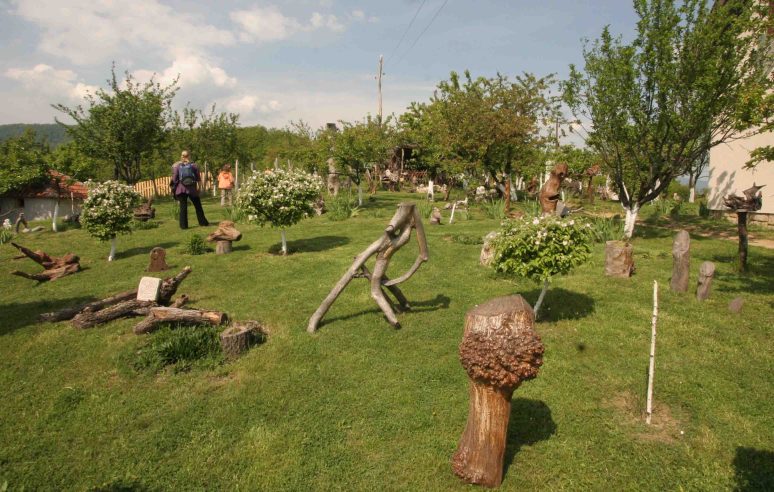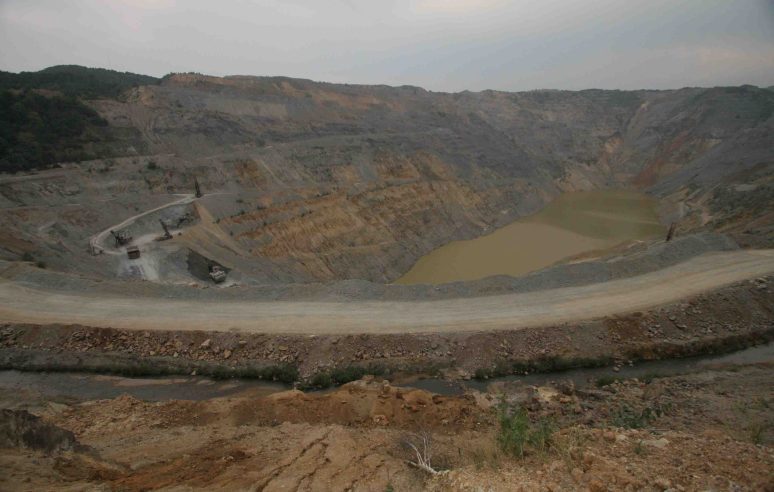Day trip to Djerdap
It is possible to make a day trip to Djerdap, although two days is better. There are hotels in Donji Milanovac and Kladovo
and private rooms. To drive there, take the motorway towards Nis, exit towards Pozarevac where there is a brown
sign showing Djerdap National Park. Take the road to V. Gradiste when you come to Pozarevac.
 Golubac Castle is from the 14th century. The area was very important during Roman and Early Byzantine times.
Golubac Castle is from the 14th century. The area was very important during Roman and Early Byzantine times.
 The main road goes through the castle. It can look impassible for large trucks, and you can see the scrapes on the
The main road goes through the castle. It can look impassible for large trucks, and you can see the scrapes on the
ceiling of the vault. Trucks sometimes stop in front of the castle and make a phone call to confirm it is safe to pass.
 It is possible to climb up a bit for a better view, but the staircase is very narrow.
It is possible to climb up a bit for a better view, but the staircase is very narrow.
 View from the last tunnel under the castle, towards Djerdap. There is an
View from the last tunnel under the castle, towards Djerdap. There is an
EU-project that will finance a new tunnel that will help preserve the castle.
 The museum at Lepinski Vir. There was a settlement of people that lived on the shores of Danube 8,000 years ago.
The museum at Lepinski Vir. There was a settlement of people that lived on the shores of Danube 8,000 years ago.
 Traditional buildings at Lepinski Vir. The museum is based on archeological finds from a settlement that started 7,000 BC.
Traditional buildings at Lepinski Vir. The museum is based on archeological finds from a settlement that started 7,000 BC.
 One figure displayed. The settlement peaked during 5,300 BC and 4,800 BC and consisted of ten villages.
One figure displayed. The settlement peaked during 5,300 BC and 4,800 BC and consisted of ten villages.
 The new museum at Lepinski Vir seen from the Romanian side of the Danube.
The new museum at Lepinski Vir seen from the Romanian side of the Danube.
 Kapetan Misin Breg is popular place to stop. When you drive toward Belgrade from Donji Milanovac,
Kapetan Misin Breg is popular place to stop. When you drive toward Belgrade from Donji Milanovac,
seen in the background to the right, turn east toward Majdenpeck. It is on the left after about one km east.
 Wood sculptures in the garden at Kapetan Misin Breg. It is located at N44.28.358 E022.06.342
Wood sculptures in the garden at Kapetan Misin Breg. It is located at N44.28.358 E022.06.342
 Zlata and Sasa talking to the owner of Kapetan Misin Breg. The have guest rooms and serve meals.
Zlata and Sasa talking to the owner of Kapetan Misin Breg. The have guest rooms and serve meals.
 There are statues of mammoths in Gornji Milanovac. They are the unofficial mascot of the city. Mammoth bones were found
There are statues of mammoths in Gornji Milanovac. They are the unofficial mascot of the city. Mammoth bones were found
in 1996 and 2009. The town itself was founded in the 19th century on an island in the river. It was moved to the shore in 1830,
and later moved again 1970 when the hydroelectric plant in Djerdap started, and the river water level rose by 35 meters.
 Traditional kiln to make charcoal, common in this part of Serbia.
Traditional kiln to make charcoal, common in this part of Serbia.
 There are many places that rent rooms to visitors. View from the balcony of one house we stayed at.
There are many places that rent rooms to visitors. View from the balcony of one house we stayed at.
 Private accommodation is reasonably priced. Bedrooms like this are common. Bathrooms are often shared with other guests.
Private accommodation is reasonably priced. Bedrooms like this are common. Bathrooms are often shared with other guests.
 Majdanpeck town and copper mine are far from Donji Milanovac .
Majdanpeck town and copper mine are far from Donji Milanovac .
 Rajkovs cave is a large cave in Majdanpeck, . It is located at N44.26.473 E021.57.140
Rajkovs cave is a large cave in Majdanpeck, . It is located at N44.26.473 E021.57.140
 The cave is said to have the best ornaments of the caves in Serbia.
The cave is said to have the best ornaments of the caves in Serbia.
The temperature is constant + 8 C, so dress warm if you plan to visit.
 The cave is more than 2 km deep. Outside the cave is a small meadow along a small stream. It is a nice place for a picnic.
The cave is more than 2 km deep. Outside the cave is a small meadow along a small stream. It is a nice place for a picnic.
 About 45 minutes drive east from Donji Milanovac is the Iron Gate where the Danube is narrow and at its deepest, about 83 m.
About 45 minutes drive east from Donji Milanovac is the Iron Gate where the Danube is narrow and at its deepest, about 83 m.
 Djerdap Gate, the beginning of the narrow stretch. It was difficult to pass through the Iron Gate
Djerdap Gate, the beginning of the narrow stretch. It was difficult to pass through the Iron Gate
before 1970 when the hydroelectric power plant in Djerdap started and the water rose by 35 meters.
 There is a small church on the Romanian side of the narrow passage.
There is a small church on the Romanian side of the narrow passage.
 East of the Iron Gate, there are viewpoints and picnic tables. Romania is on the other side.
East of the Iron Gate, there are viewpoints and picnic tables. Romania is on the other side.
 The portrait of the Dacian King Decebalus, the largest rock sculpture in Europe, 43 meters high and 25 meters wide.
The portrait of the Dacian King Decebalus, the largest rock sculpture in Europe, 43 meters high and 25 meters wide.
It was made between 1994-2004 to counterbalance the Trajan Tablet on the Serbian side. The Tablet was ordered
by Emperor Trajan to mark the Roman victory over the Dacians in 105. The rock sculpture was financed
by a Romanian businessman, Giuseppe Constantiono Dragan, who spent USD 1 million.
 You can only see the Trajan Tablet from the water and if you are lucky you will find where to take a boat.
You can only see the Trajan Tablet from the water and if you are lucky you will find where to take a boat.
 The Trajan tablet as seen from Romania. Since the water rose, the only way to get close to the Tablet is from the water.
The Trajan tablet as seen from Romania. Since the water rose, the only way to get close to the Tablet is from the water.

